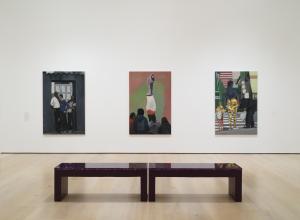
Claude Monet, Grainstacks at Giverny, Sunset, 1888–89.
Born in Paris in 1840, Claude Monet became a master painter whose works have become synonymous with the Impressionist movement he helped found. An avid experimenter, Monet was known for painting the same subjects time and again, drawing inspiration from the unique qualities of color and light he saw each time he attempted to recreate it, leading to a wide, vibrant body of work.
Here are eleven little-known facts about the life of Claude Monet.

Claude Monet, Caricature of Jules Didier (“Butterfly Man”), c. 1858.
Monet displayed keen artistic sensibilities from childhood and attended the Le Havre secondary school of the arts in 1851. But the artist wasn’t always known for his paintings. When he was fifteen, Monet was a caricaturist and sold charcoal drawings.

Eugène Boudin, Le Havre, The Port, 1884.
Today, Monet is known for his ability to capture light in dramatic landscapes, but at age fifteen, it was the landscape painter Eugène Boudin who inspired Monet to leave caricatures behind. In 1856, Boudin taught Monet to paint outdoors, or en plein air, on the beaches of Normandy, where he studied the changing weather and light.
At the time, painting outside was relatively uncommon, though it later became an important part of the Impressionist movement. Monet later said his success as a painter was due to Eugène Boudin.

Portrait of Monet by Nadar.
In 1868, an impoverished Monet faced severe depression and attempted to kill himself by jumping off a bridge into the Seine. Though Monet survived the fall and became one of the most prominent painters of the late 19th and early 20th centuries, he struggled with depression for the rest of his life.

Claude Monet, Impression, Sunrise, 1872.
Though he didn’t know it when he titled it, Monet’s painting Impression, Sunrise, painted in 1873, became the inspiration for the name of the artistic movement for which the artist is so well known.
In 1874, Claude Monet, Edgar Degas, Camille Pissarro, Édouard Manet, and Paul Cézanne, founded the Anonymous Society of Painters, Sculptors, and Printmakers, etc., along with several other artists whose works were rejected by the Salon. The group held an exhibition of their work that year in Paris. This showing later became known as the first Impressionist exhibition.
The works at the exhibition received many critical reviews, one of which was written by Louis Leroy, who latched onto Monet’s use of the word “impression” in the title of his painting as a derogatory description of what called the “unfinished” nature of Monet’s painting.
The artists then defiantly adopted the term impressionist to describe their work, and it became the name of the movement.

Monet, on the right, in his garden.
In 1883, Monet’s family moved to Giverny and started the famous garden that still stands at his home today. In 1893, Monet bought extra land and diverted water from river to create his water garden. Wanting to make the garden as aesthetically pleasing as possible, he imported plants from all over the world, including his iconic water lilies. His neighbors, however, were cattle farmers and were afraid that his new aquatic plants would poison the water and kill their animals.
Local authorities told Monet to remove the plants, but he ignored them, and the lilies became one of his greatest sources of inspiration.

Claude Monet, Water Lilies, 1906.
When people think of Monet, it’s no wonder many immediately think of water lilies. Over the last three decades of his life, water lilies became the subject of around 250 of Monet’s paintings.

Claude Monet, Water Lilies and the Japanese Bridge, 1897-99.
When Monet wanted to paint his water lilies, a gardener had to row a small boat onto the pond and gently push each one into the water to clean off any dust that had accumulated before Monet could begin working.

Claude Monet, Grainstacks at Giverny, Sunset, 1888–89.
Though water lilies were certainly Monet’s most-painted subject, it wasn’t the only one he revisited throughout his life. Monet often created series of paintings exploring the way light changed the same landscape at different times of day, in different seasons, and in different weather conditions.
In addition to the water lilies, he also painted a series featuring Haystacks from 1890–1891 and a series of paintings of the Rouen Cathedral from 1892–1894.

Claude Monet, Water Lilies, c. 1915–1926.
In 1905, Monet was sixty-five and began to notice changes to his vision. The colors he saw were no longer as bright, and his paintings began to feature more yellow and purple tones. In 1912, when he was seventy-two, Monet was diagnosed with nuclear cataracts in both eyes.
Because Monet so often repainted the same subjects over the years, viewers can trace the way cataracts affected his vision over time. Scientists have even studied changes in the color and style of Monet’s paintings over time—along with the works of his fellow Impressionist, Degas, who also had eye disease. By using computers to simulate the blurriness one would see with eye disease, scientists have been able to find out how the artists likely saw their own paintings, which has given new insights into the artists’ works.

Claude Monet, The House among the Roses, 1925.
Initially, Monet did not want to have surgery to correct his cataracts, because he had seen other artists’ careers ended by failed surgery, such as Mary Cassatt. Monet finally agreed to have cataract surgery on his right eye in 1923, but he did not have the surgery on his left eye, which still had cataracts and could not see violets or blues.
During the surgery on his right eye, however, the lens of his eye was removed, which let more light into the eye. Because the lens is the part of the eye that filters out ultraviolet light, it is believed that Monet might have begun seeing ultraviolet wavelengths, which humans typically cannot see. After the surgery, he used more blues in his water lily paintings, which could indicate he was seeing ultraviolet light.

Claude Monet, The Japanese Footbridge, 1920–1922.
Monet was known for destroying his own work when he was dissatisfied with paintings or angry. In 1908, he cut at least fifteen water lily paintings with a knife, which caused a show of his work in Paris to be postponed. Later, after his cataract surgery, he destroyed many of the paintings he created when he suffered the worst of his vision problems. Altogether, he is thought to have destroyed up to 500 of his own paintings.
Peggy Carouthers
Peggy Carouthers is a writer, editor, and custom content manager based in California. She enjoys creative writing and learning about art and literature. She is passionate about connecting companies with audiences.























